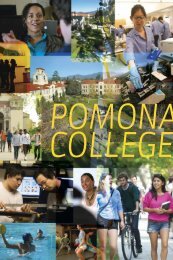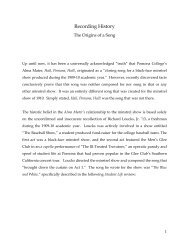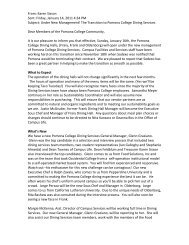Create successful ePaper yourself
Turn your PDF publications into a flip-book with our unique Google optimized e-Paper software.
28<br />
If you want<br />
Becoming<br />
Colleagues Summer Sampler<br />
REAL-WORLD CHALLENGES, PART 1<br />
to try your hand<br />
at research, you won’t have to wait long before getting<br />
your feet wet at <strong>Pomona</strong>. A number of our students<br />
are already immersed in projects in their first year,<br />
tackling sophisticated research in nanotechnology,<br />
DNA and aging, and dwarf planetary rotation. The<br />
<strong>College</strong> offers extensive opportunities in all disciplines,<br />
from creating digital biographies in media studies to<br />
studying thermophilic organisms at Coso Hot Springs<br />
in chemistry. Students work side-by-side with<br />
professors in the classroom and the lab as part of the<br />
regular curriculum and on year-round and summer<br />
research projects. Seniors also work extensively with<br />
faculty on their final research projects and theses.<br />
Conducting research as an undergraduate not only<br />
gives students an advantage when applying for<br />
fellowships or graduate school; it also gives them a<br />
chance to tackle real-world problems and to find out<br />
what it’s like to be treated as colleagues by their<br />
professors, many of whom are among the leading<br />
experts in their fields.<br />
The Summer Undergraduate Research Program (SURP) enables students to<br />
conduct extended, focused research in close cooperation with a <strong>Pomona</strong><br />
faculty member. Research projects, funded by <strong>Pomona</strong> and by public and<br />
private foundations, take place both on campus and in the field. Although<br />
the natural sciences account for the largest number of projects, the<br />
humanities, social sciences and interdisciplinary disciplines are also well<br />
represented. An average of 120 students work on research projects each<br />
summer. Below is a sampling of some recent projects.<br />
Art and Art History<br />
Here, Now and Why: Place-Specific<br />
Contemporary Southern California Art<br />
in Context<br />
Asian Studies<br />
Asian Exceptionalism? Continuing the<br />
Asian Values Debate<br />
Astronomy<br />
Berkeley 87: Stellar Variability of a<br />
Young Star Cluster<br />
Biology<br />
Mutation-Selection Balance in Ciliates<br />
Chemistry<br />
Development of a Method for<br />
Analyzing Biodiesel using High<br />
Performance Liquid Chromatography<br />
Computer Science<br />
The Implementation of Object-<br />
Oriented Languages in Pedagogical<br />
Programming Environments<br />
Economics<br />
What Happens to Children When<br />
Their Families Fail?<br />
English<br />
Alienation and Paranoia in Urban<br />
Environments<br />
Environmental Analysis<br />
The Impacts of Fish Farming in the<br />
Peruvian Amazon<br />
Geology<br />
The Influence of Normal Fault<br />
Geometry on Porous Sandstone<br />
Deformation: Insights from<br />
Mechanical Models<br />
History<br />
The Japanese-American’s Struggle<br />
with Identity in World War II<br />
Linguistics and Cognitive Science<br />
A Purloined Letter: Why Do We Miss<br />
Things Right Before Our Eyes?<br />
Mathematics<br />
The Yang-Baxter Equation and<br />
Integrable Systems<br />
Media Studies<br />
An Experiential Study In Live<br />
Music Culture<br />
Molecular Biology<br />
Studies into the Origins of the<br />
Adaptive Immune System<br />
Neuroscience<br />
Group Differences in Stress, EEG<br />
Prefrontal Asymmetry and Health<br />
Physics<br />
Caging Atoms with Light: The<br />
Magneto-Optical Trap<br />
Politics<br />
Human Trafficking in Argentina<br />
Psychology<br />
The Effect of Verbal and Nonverbal<br />
Interventions on TOT Resolution<br />
Religious Studies<br />
Theology of Inculturation in<br />
Northern Peru<br />
Sociology<br />
Who Gets Designated a Terrorist and<br />
Why? A Comparative Cross-Sectional<br />
Analysis of Government Terrorist Lists<br />
www.pomona.edu/admissions<br />
A Journey to the Arctic<br />
Nina Karnovsky, an associate<br />
professor of biology, has been traveling to the<br />
Arctic since 1997 to study seabirds. For the past<br />
two summers, she has taken a <strong>Pomona</strong> student<br />
along on her summer research expeditions.<br />
Background<br />
Bailey: I grew up in Livermore, home to a nuclear lab, wine grapes and<br />
cowboys. My dad, who is a high school biology teacher, got me interested in<br />
the natural world by taking me hiking and on camping trips to Yosemite. I<br />
also had an excellent AP bio teacher in high school.<br />
Karnovsky: I was not at all interested in science and even petitioned out of<br />
my science classes when I was at Wesleyan. My epiphany came after I<br />
graduated, when I came to California and got at job at Point Reyes Bird<br />
Observatory teaching kids about birds. I fell in love with research and started<br />
taking seasonal jobs,<br />
studying Goshawks in the<br />
Grand Canyon, elephant<br />
seals on the Farallon<br />
Islands and sea turtles in<br />
Hawaii. Ten years ago, I<br />
started working in the<br />
Arctic, which is where I did<br />
the research for my Ph.D.<br />
B: I grew up hearing<br />
about the close<br />
relationships that my<br />
grandparents (professors<br />
at Scripps and <strong>Pomona</strong>)<br />
had with their students—<br />
enjoying discussions,<br />
having dinners for students<br />
at their house, keeping in contact with their advisees after graduation. I<br />
came here because I wanted to have that same kind of academic interaction.<br />
After my sophomore year, I spent part of the summer studying birds in the<br />
Eastern Sierras with Professor Levin [Rachel Levin, associate professor of<br />
biology]. Then I took a vertebrate biology course from Professor Karnovsky<br />
before heading to South Africa for my semester abroad. I was in South<br />
Africa, sitting in this little Internet café in the heat of the summer, when I got<br />
an email from her asking me to be her research assistant. I was ecstatic. I<br />
didn’t have to think twice about accepting the job.<br />
K: I could see Allison had the qualities I look for in a field assistant. She was<br />
enthusiastic, easy to get along with, and good at designing projects—I have<br />
students in all my classes design their own fieldwork and carry it out. I<br />
thought she’d be a great candidate and I was right.<br />
The Research Project: Currents of Change: How will the Feeding<br />
Ecology of the Little Auk (Alle Alle) Change with Global Climate Change<br />
The Location: The Polish Polar Station, Polar Bear Bay, Hornsund<br />
Fjord, Spitsbergen Island, Norway<br />
The Research<br />
K: When I went to the Antarctic in 1992 I realized how any<br />
change in the food web is quickly transmitted to birds. They’re<br />
responsive to changes in ice conditions and warming, and that<br />
changes their behavior, which is something we can measure.<br />
B: Because little auks eat plankton, they’re good indicators of<br />
what’s happening in the ocean. What’s cool about the place<br />
where we were is that there are two currents. In addition to<br />
being different temperatures, they have different types of<br />
plankton. When there’s a lot of warm water and just a slice of<br />
cold, the little auks mostly feed on the small plankton. When<br />
the cold current dominates, you get a lot of energy-rich prey.<br />
We have data for several years on where the currents are,<br />
where the zooplankton are and what the currents are doing.<br />
K: With such a short-term study we haven’t measured huge<br />
declines in productivity, but one of the things we’re doing is<br />
comparing our colony, which has a lot of warm water around<br />
it, to another colony in Greenland—same species of bird—<br />
surrounded by a lot of cold water.<br />
Getting There<br />
K: We flew from California to Newark to Oslo to the northern tip of Norway. Then it was on<br />
to Longyearbyen and a two-day boat trip down to the Polish Polar Station.<br />
B: There are about 25 people at the station in the summer, 10 in the winter. While we<br />
were there, people were coming and going – scientists from Belgium and Norway, Spanish<br />
glaciologists. Most of the researchers are from Poland.<br />
K: One of the things I love about polar research is that it’s so international. That’s another<br />
reason I chose Allison because I knew she would enjoy the social part of the experience<br />
because she was making the most of her study abroad experience in South Africa.<br />
B: Capturing the chicks and adult birds for measurements<br />
doesn’t require any special techniques. The chicks nest in rock<br />
crevices and you have to just reach in and grab them. The<br />
adults, which look like small penguins but can fly, require<br />
a net.<br />
K: It’s daylight all the time when we’re there so we have to<br />
keep working because the birds don’t stop. A lot of people<br />
have a romanticized idea of what field research will be like. It<br />
takes a lot of perseverance – conditions can be really<br />
uncomfortable and animals don’t behave like you think they<br />
might. Having this experience while you’re an undergraduate<br />
helps when you need to make a decision about whether to go<br />
to grad school in an area that involves field work.<br />
B: We also spent three days on a large three-masted sailboat<br />
that took us out to sea to collect samples in the currents of<br />
cold and warm water where the auks find their food. You can<br />
be sitting on the deck counting birds...nothing, one, nothing,<br />
nothing…3,400!<br />
Allison Bailey, a senior majoring in<br />
biology, was the latest field assistant to spend four<br />
weeks at the Polish Polar Station.<br />
Back to <strong>Pomona</strong><br />
K: I’m happy I can give my students an opportunity to experience all levels<br />
of a project. Allison was in the field for the data collection and has been<br />
helping with the analyses and doing her own analysis for her senior thesis.<br />
She wrote a poster and presented it at the Pacific Seabird Group meeting,<br />
where she got an honorable mention. A few people asked when she was<br />
going to get her Ph.D. I told them she was just graduating from college.<br />
B: It’s been very cool. In addition to learning about biology, it’s been<br />
interesting to make the connection between climate and predators. I’ve<br />
also appreciated having a role model<br />
like Professor Karnovsky. To have strong<br />
women scientists in this department,<br />
who can do so many different things,<br />
is awesome.<br />
The “Arctic Flu”<br />
Allison was awarded a Fulbright to return<br />
to the Arctic to study at the university in<br />
Longyearbyen, where she’ll look at the<br />
relationship between migrating geese and<br />
plants of the tundra and how they are<br />
affected by climate change. She’ll<br />
probably cross paths with Laurel<br />
McFadden ‘06, who also spent a summer<br />
as a research assistant for Karnovsky and<br />
was awarded a Watson Fellowship to<br />
photograph people north of the Arctic<br />
Circle. Karnovsky will also go back, this<br />
time with three students from <strong>Pomona</strong>.<br />
They will all be there for the International<br />
Polar Year, a collaborative international<br />
effort to study the polar regions that<br />
takes place every 50 years.<br />
K: Every student I bring to the Arctic gets<br />
the “Arctic flu.” You catch the bug and<br />
you have to go back. It becomes a part of<br />
you. One of the things I love about it<br />
that’s different from the Antarctic is that<br />
there are all these wildflowers and land<br />
mammals, in addition to the huge<br />
number of seabirds. It’s extraordinarily<br />
beautiful – harsh, stark, but full of color.<br />
29


![Pomona College View Book [pdf]](https://img.yumpu.com/7994157/30/500x640/pomona-college-view-book-pdf.jpg)
![Anticipated Courses SP14 [pdf] - Pomona College](https://img.yumpu.com/25429326/1/190x245/anticipated-courses-sp14-pdf-pomona-college.jpg?quality=85)

![to download a brochure [pdf] - Pomona College](https://img.yumpu.com/25429319/1/190x245/to-download-a-brochure-pdf-pomona-college.jpg?quality=85)

![Year End Report 09-10 [pdf] - Pomona College](https://img.yumpu.com/25429304/1/190x245/year-end-report-09-10-pdf-pomona-college.jpg?quality=85)
![Download it here [pdf] - Pomona College](https://img.yumpu.com/25429302/1/190x245/download-it-here-pdf-pomona-college.jpg?quality=85)
![Fall 2010 Pomona College Magazine here [pdf]](https://img.yumpu.com/25429298/1/190x219/fall-2010-pomona-college-magazine-here-pdf.jpg?quality=85)
![FAQs for Prospective Music Students [pdf] - Pomona College](https://img.yumpu.com/25429289/1/190x245/faqs-for-prospective-music-students-pdf-pomona-college.jpg?quality=85)
![Year End Report 10-11 [pdf] - Pomona College](https://img.yumpu.com/25429286/1/190x245/year-end-report-10-11-pdf-pomona-college.jpg?quality=85)
![Student Orientation Schedule [pdf] - Pomona College](https://img.yumpu.com/25429282/1/190x89/student-orientation-schedule-pdf-pomona-college.jpg?quality=85)
![Schaefer - 2010 [pdf] - Pomona College](https://img.yumpu.com/25429269/1/190x245/schaefer-2010-pdf-pomona-college.jpg?quality=85)
![C. Freshman Admission [pdf] - Pomona College](https://img.yumpu.com/25429268/1/190x245/c-freshman-admission-pdf-pomona-college.jpg?quality=85)


